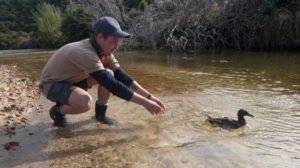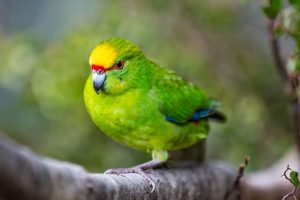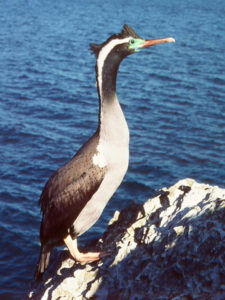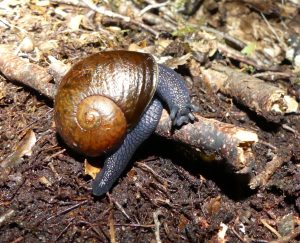
DOC biodiversity ranger Dan Arnold releases a pāteke
We were delighted to welcome 72 new pāteke at Hadfield Clearing on Thursday 3 May.
They were released on the banks of the lower Awapoto River, at Hadfield Clearing, near Awaroa. The translocation follows a successful release of 20 of the ducks by Project Janszoon and DOC last year.
90% of the ducks released in 2017 have survived their first year, with two pairs breeding and hatching 12 ducklings. There are only 2,500 pāteke left in the wild, mainly in the North Island.
“Being able to release 70 more birds shows the Department of Conservation’s Pāteke Recovery Group has confidence in the habitat and in our predator control. Project Janszoon and DOC have undertaken extensive predator control at the release site, particularly focusing on feral cats and stoats,” says our ornithologist Ron Moorhouse.
The juvenile ducks have been bred around New Zealand and spent time at the Isaac Conservation and Wildlife Trust facility in Christchurch for pre-release conditioning. DOC’s long-term partner Air New Zealand flew the birds from Christchurch to Nelson. They were then choppered to Hadfield Clearing.
The birds were blessed by representatives from Golden Bay iwi Manawhenua ki Mohua. “We are delighted the first birds have done so well and more are being released. A karakia helps safeguard the pāteke in their new home,” says Manawhenua ki Mohua representative John Ward-Holmes.
Pāteke Recovery Group captive coordinator Kevin Evans says trapping is obviously working well and hopefully the ducks will continue to survive and breed, producing a self-sustaining population.
“The team has done a brilliant job. The increased number of pāteke are likely to spread into the wider surroundings so I would love to see nearby residents forming landcare groups to undertake predator control around the periphery of the Park to increase protection for the ducks,” he says.
The pāteke have so far been seen at Totaranui, and near the Awaroa Lodge. DOC biodiversity ranger John Henderson says it is a pat on the back to be allowed to release more and 20 from this latest release will be closely monitored.
“With more ducks we will increase the number of feeders as captive bred birds need time to get used to wild food. So far most of the ducks have stuck around the release site, but with 72 extra it will be interesting to see how far they go,” he says.
Nearly 90% of the Abel Tasman National Park is currently stoat trapped, and feral cats are trapped in the Awaroa area to protect the ducks.



